
The Soldiers and Sailors Monument is a monument erected in Boston Common in downtown Boston, dedicated to soldiers and sailors of the Commonwealth of Massachusetts who died in the American Civil War. Designed by Martin Milmore, construction began in 1874 and the monument was dedicated on September 17, 1877. Union Generals George B. McClellan and Joseph Hooker were among the estimated 25,000 people attending the dedication on Boston Common.
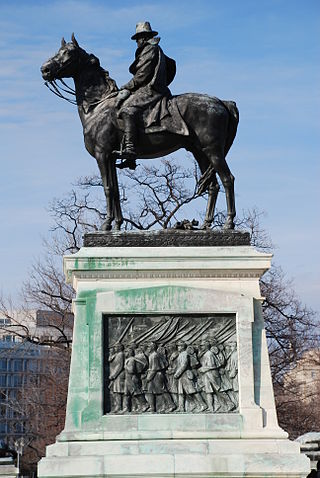
The Ulysses S. Grant Memorial is a presidential memorial in Washington, D.C., honoring American Civil War general and 18th president of the United States, Ulysses S. Grant. It sits at the base of Capitol Hill, below the west front of the United States Capitol. Its central sculpture of Grant on horseback faces west, overlooking the Capitol Reflecting Pool and facing toward the Lincoln Memorial, which honors Grant's wartime president, Abraham Lincoln. Grant's statue is raised on a pedestal decorated with bronze reliefs of the infantry; flanking pedestals hold statues of protective lions and bronze representations of the Union cavalry and artillery. The whole is connected with marble covered platforms, balustrades, and stairs. The Grant and Lincoln memorials define the eastern and western ends, respectively, of the National Mall.
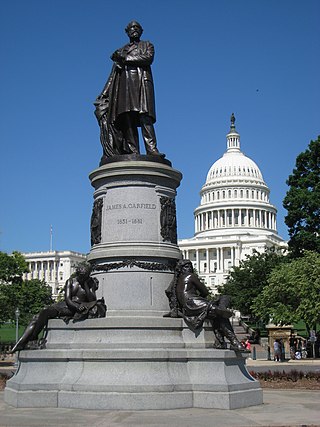
The James A. Garfield Monument stands on the grounds of the United States Capitol in the traffic circle at First Street and Maryland Avenue SW in Washington, D.C. It is a memorial to U.S. President James A. Garfield, who was elected in 1880 and assassinated in 1881 after serving only four months of his term. The perpetrator was an attorney and disgruntled office-seeker named Charles J. Guiteau. Garfield lived for several weeks after the shooting, but eventually succumbed to his injuries. The monument is part of a three-part sculptural group near the Capitol Reflecting Pool, including the Peace Monument and the Ulysses S. Grant Memorial in Union Square. The monument is also a contributing property to the National Mall and L'Enfant Plan, both of which are listed on the National Register of Historic Places and the District of Columbia Inventory of Historic Sites. The bronze statue rests on a granite pedestal that features three sculptures, each one representing a time period in Garfield's life.
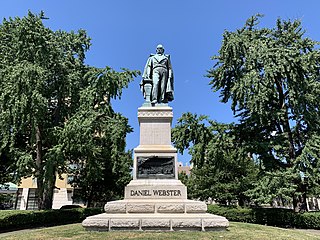
The Daniel Webster Memorial is a monument in Washington, D.C., honoring U.S. statesman and lawyer Daniel Webster. It is located near Webster's former house, beside Scott Circle, at the intersection of Massachusetts Avenue, N Street, and Rhode Island Avenue NW. The person who commissioned the memorial was Stilson Hutchins, founder of The Washington Post, who greatly admired Webster. Congress approved the memorial in 1898 and the dedication ceremony took place in January 1900. Amongst the attendees at the ceremony were President William McKinley and his cabinet, members of Congress, and Supreme Court justices.

The Trenton Battle Monument is a massive column-type structure in the Battle Monument section of Trenton, Mercer County, New Jersey, United States. It commemorates the December 26, 1776, Battle of Trenton, a pivotal victory for the Continental forces and commander George Washington during the American Revolutionary War.
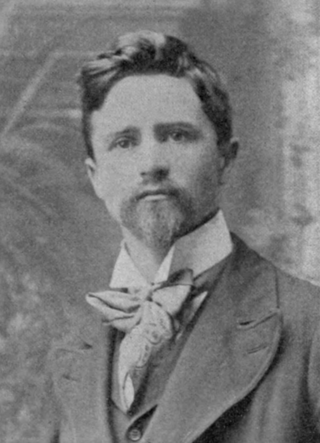
Sigvald Asbjørnsen was a Norwegian-born American sculptor.

Oliver P. Morton and Reliefs is a public artwork by Austrian artist Rudolph Schwarz, located on the east side of the Indiana Statehouse in Indianapolis, Indiana, at the intersection of North Capitol Avenue and West Market Street.

Major General George Henry Thomas, also known as the Thomas Circle Monument, is an equestrian sculpture in Washington, D.C. that honors Civil War general George Henry Thomas. The monument is located in the center of Thomas Circle, on the border of the downtown and Logan Circle neighborhoods. It was sculpted by John Quincy Adams Ward, best known for his work on the statue of George Washington in Wall Street, Manhattan. Attendees at the dedication in 1879 included President Rutherford B. Hayes, Generals Irvin McDowell, Philip Sheridan, and William Tecumseh Sherman, senators and thousands of soldiers.

Brigadier General Thaddeus Kościuszko is a bronze statue honoring Polish military figure and engineer Tadeusz Kościuszko. The sculpture was dedicated in 1910, the third of four statues in Lafayette Square, Washington, D.C., to honor foreign-born heroes of the American Revolutionary War. Born in the Polish–Lithuanian Commonwealth in 1746, Kościuszko later received education at a Jesuit school before attending the Corps of Cadets in Warsaw. He later traveled to France where he studied in military academy libraries and adopted views of human liberty during the Age of Enlightenment. He moved to the Thirteen Colonies in 1776, where the war with the Kingdom of Great Britain had already begun. Kościuszko served as an engineer in the Continental Army, earning the praise of his superiors, including General George Washington.

Carl Wilhelm Daniel Rohl-Smith was a Danish American sculptor who was active in Europe and the United States from 1870 to 1900. He sculpted a number of life-size and small bronzes based on Greco-Roman mythological themes in Europe as well as a wide number of bas-reliefs, busts, funerary monuments, and statues throughout Denmark, the German Confederation, and Italy. Emigrating to the United States in 1886, he once more produced a number of sculptures for private citizens. His most noted American works were a statue of a soldier for a Battle of the Alamo memorial in Texas, a statue of Benjamin Franklin for the World's Columbian Exposition in 1893, a statue group in Chicago commemorating the Fort Dearborn Massacre, and the General William Tecumseh Sherman Monument in Washington, D.C.

The Civil War Monuments in Washington, D.C. are a group of seventeen outdoor statues which are spread out through much of central and northwest Washington, D.C. The statues depict 11 Union generals and formerly included one Confederate general, Albert Pike, who was depicted as a Mason and not as a general. The Pike statue was torn down on Juneteenth 2020, as part of the George Floyd protests. Two Union admirals are honored, although Admiral Samuel Francis DuPont's statue was removed to Wilmington, Delaware, and he is now honored with a fountain. Other statues depict nuns, peace, emancipation, and the Grand Army of the Republic.

Abraham Lincoln is a marble sculpture of U.S. President Abraham Lincoln by Irish artist Lot Flannery, located in front of the old District of Columbia City Hall in Washington, D.C., United States. The statue is the nation's oldest extant memorial to the president and was installed several blocks from Ford's Theatre, where Lincoln was assassinated. Flannery was present at the theater on the night of Lincoln's assassination.

William Tecumseh Sherman, also known as the Sherman Memorial or Sherman Monument, is a sculpture group honoring William Tecumseh Sherman, created by Augustus Saint-Gaudens and located at Grand Army Plaza in Manhattan, New York. Cast in 1902 and dedicated on May 30, 1903, the gilded-bronze monument consists of an equestrian statue of Sherman and an accompanying statue, Victory, an allegorical female figure of the Greek goddess Nike. The statues are set on a Stony Creek granite pedestal designed by the architect Charles Follen McKim.
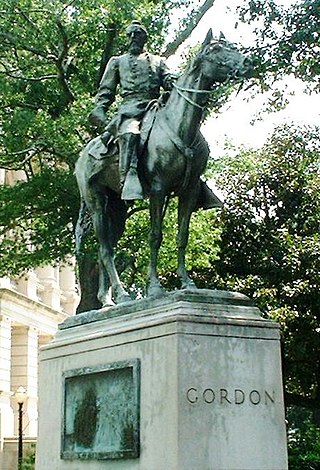
The equestrian statue of John Brown Gordon is a monument on the grounds of the Georgia State Capitol in Atlanta, Georgia, United States. The monument, an equestrian statue, honors John Brown Gordon, a general in the Confederate States Army during the American Civil War who later become a politician in post-Reconstruction era Georgia. Designed by Solon Borglum, the statue was dedicated in 1907 to large fanfare. The statue has recently become a figure of controversy over Gordon's racist views and associations with the Confederacy, with some calling for its removal.

Commodore George Hamilton Perkins is a public memorial that stands on the grounds of the New Hampshire State House in Concord, New Hampshire, United States. The statue was designed by sculptor Daniel Chester French, with architect Henry Bacon designing the remainder of the public monument. It honors George H. Perkins, a New Hampshire native who had served as an officer in the United States Navy during the American Civil War. The statue was dedicated in 1902.
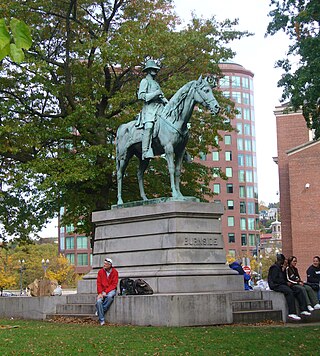
Major General Ambrose E. Burnside, also known as the Ambrose Burnside Monument, is a monumental equestrian statue in Providence, Rhode Island, United States. The statue, located in the city's Burnside Park, was designed by sculptor Launt Thompson and depicts Ambrose Burnside, an officer in the Union Army during the American Civil War who later served as the governor of Rhode Island. Ambrose had died in 1881 and the project to erect a statue in his honor began shortly afterwards. It was dedicated on July 4, 1887 in a large ceremony that included several notable guests of honor, such as General William Tecumseh Sherman, Colonel Robert Hale Ives Goddard, and the governors of both Connecticut and Rhode Island. The monument was originally located in Exchange Place, but it was moved to its current location in the early 1900s. As part of the move, the pedestal was replaced with one designed by William R. Walker.

General Alexander Macomb is a monumental statue in Detroit, Michigan, United States. It was designed by sculptor Adolph Alexander Weinman and was dedicated in 1908 in honor of Alexander Macomb, a Detroit native who had served as the Commanding General of the United States Army for several years in the early 1800s. The monument, which consists of the bronze statue of Macomb standing atop a granite pedestal on a circular concrete platform, was dedicated on September 11, on the anniversary of the Battle of Plattsburgh, a War of 1812 battle that Macomb had participated in. Since the 2010s, the statue has come under criticism due to Macomb's connections to slavery and the mistreatment of Native Americans, with several news sources publishing opinion pieces calling for the statue's removal. During the George Floyd protests in 2020, the monument was vandalized several times.

Major General David McMurtrie Gregg is a monumental statue located in Reading, Pennsylvania, United States. The monument was designed by Henry Augustus Lukeman and consists of an equestrian statue depicting David McMurtrie Gregg, a military officer who had served in the Union Army during the American Civil War. The monument was dedicated in 1922, several years after Gregg's death in Reading in 1916.























